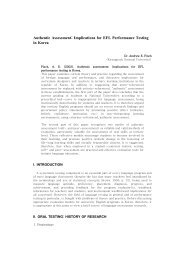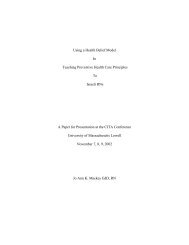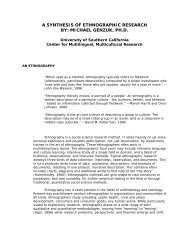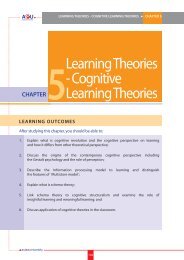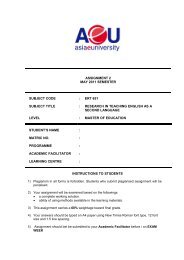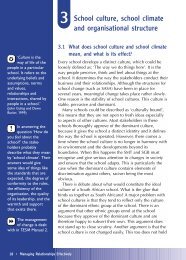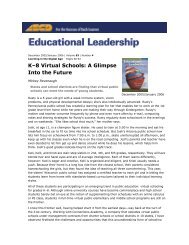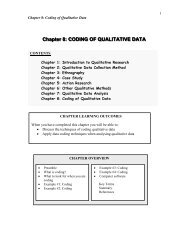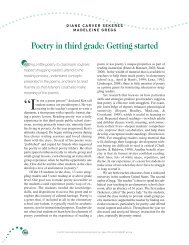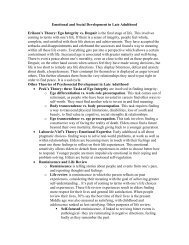Teaching Romeo and Juliet to ESL Students in ... - learningdomain
Teaching Romeo and Juliet to ESL Students in ... - learningdomain
Teaching Romeo and Juliet to ESL Students in ... - learningdomain
Create successful ePaper yourself
Turn your PDF publications into a flip-book with our unique Google optimized e-Paper software.
debates, journals, discussions, <strong>and</strong> activities. As we are read<strong>in</strong>g the s<strong>to</strong>ry, students willread first a summary of each scene <strong>to</strong> make it easier <strong>to</strong> underst<strong>and</strong>. We will read anadaptation of the play for middle school but I will <strong>in</strong>troduce, as much as possible,selected key speeches from the orig<strong>in</strong>al work. I will avoid read<strong>in</strong>g the longest scenes ofShakespeare’s work because I know my students’ limits. To make it easier, we willassign students short read<strong>in</strong>gs for homework <strong>and</strong> will allow them <strong>to</strong> work <strong>in</strong> pairs orgroups <strong>to</strong> help each other. The student’s participation <strong>and</strong> <strong>in</strong>volvement <strong>in</strong> theassignments <strong>and</strong> <strong>in</strong> the development of the activities is imperative for this unit. Theteacher <strong>and</strong> the activities will be only a guide for them <strong>to</strong> discover. The teacher will givestudents clues through the entire unit: <strong>to</strong> let them discover through the language all themysteries locked <strong>in</strong> Shakespeare. We will ask questions so that they can f<strong>in</strong>d out <strong>and</strong>follow the clues <strong>to</strong> f<strong>in</strong>d the treasure, as a detective.Sequence of ActivitiesTo start deal<strong>in</strong>g with the ma<strong>in</strong> <strong>to</strong>pics of the play, we just need <strong>to</strong> read Act I. In the firstact, students learn of the feud. We can guide an open debate about students’ experienceswith arguments, <strong>in</strong>sults, gangs <strong>in</strong> the school <strong>and</strong> the way they feel when they are <strong>in</strong>volved<strong>in</strong> a fight. We can ask them for homework <strong>to</strong> write a journal about the reasons whypeople fight. I might ask questions like:1. Do any of your parents dislike the parents of one of your friends?2. How do you behave?3. Are you more <strong>in</strong>cl<strong>in</strong>ed <strong>to</strong> side with your parents?4. Do you defend friendship above your parents’ decisions?When deal<strong>in</strong>g with the <strong>to</strong>pic of love <strong>in</strong> 1.2 <strong>and</strong> 1.3, the same strategies can beused. <strong>Students</strong> can express their own experience about love, feel<strong>in</strong>gs <strong>and</strong> relationships,<strong>and</strong> connect it <strong>to</strong> Shakespeare’s treatment of love. I will choose some questions <strong>to</strong> attractstudent’s attention avoid<strong>in</strong>g any k<strong>in</strong>d of embarrassment. In 2.2, the balcony scene, wecan ask students for another journal <strong>to</strong> express their op<strong>in</strong>ions <strong>and</strong> reasons <strong>to</strong> believe ornot <strong>in</strong> love at first sight. With this particular scene, students will try <strong>to</strong> perform the scenefor their first time with their script <strong>and</strong> experience the romantic love felt <strong>in</strong> Shakespeare’stimes.In 1.5 the sett<strong>in</strong>g is the masquerade <strong>in</strong> Capulet’s mansion. I will suggest a contest <strong>in</strong>the classroom <strong>to</strong> reward the best mask. <strong>Students</strong> will create their own mask <strong>in</strong> theclassroom <strong>and</strong> prizes will be given accord<strong>in</strong>g <strong>to</strong> their creativity <strong>and</strong> their effort. We canrelate this scene <strong>to</strong> the Mardi Grass Parade <strong>in</strong> Galves<strong>to</strong>n s<strong>in</strong>ce students are very familiarwith it.For students that need more of a challenge, we can give them an extra activity afterread<strong>in</strong>g 1.5 <strong>to</strong> search for some imagery <strong>in</strong> the orig<strong>in</strong>al work <strong>and</strong> name the items <strong>Juliet</strong> hasbeen compared <strong>to</strong>. For example, <strong>Juliet</strong> is “The sun” (2.2.3), “A bright angel” ( 2.2.26).62



